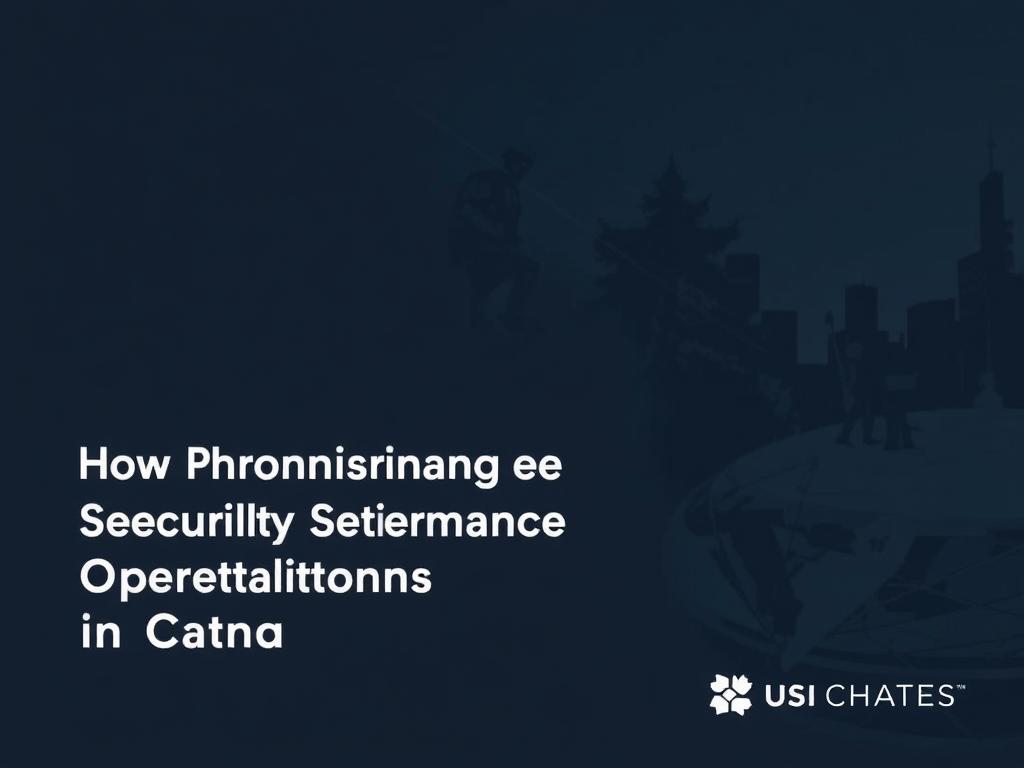Climate change is no longer just a distant environmental issue; it has become an immediate challenge that is reshaping every aspect of our lives, including how nations protect their people and infrastructure. In Canada, a country known for its vast landscapes and diverse climate, the impact of climate change on security operations is becoming increasingly significant. From extreme weather events to rising sea levels, these changes are forcing security agencies to adapt their strategies, improve their preparedness, and rethink traditional operational frameworks.
In this article, we’ll explore how climate change is affecting security operations in Canada in detail. We’ll discuss the implications of extreme weather, changing emergency response protocols, the challenges posed by infrastructure vulnerability, and how the Canadian government and security agencies are responding to these evolving threats. This comprehensive overview aims to shed light on the complex relationship between climate change and national security, making clear why this is a critical issue for Canada today and in the future.
The Rising Threat of Extreme Weather and Its Impact on Security

Canada has experienced a noticeable increase in extreme weather events over the past decade, including floods, wildfires, ice storms, and heatwaves. These events not only endanger lives and property but also directly affect security operations. Emergency response teams, law enforcement, and military units often find themselves stretched thin as they respond to these incidents.
Floods, for example, have become more frequent and severe, especially in provinces like Quebec and Ontario. These floods often necessitate large-scale evacuations, demanding significant coordination between federal, provincial, and local security forces. Responding to such emergencies requires rapid deployment of resources, crowd control, infrastructure protection, and communication management—all critical components of modern security operations.
Wildfires in western Canada, such as in British Columbia and Alberta, have also surged. These fires not only threaten communities but also disrupt transportation routes and energy supplies, complicating the logistics for security personnel. The smoke and fire hazards put responders at risk, while the simultaneous displacement of residents requires the setting up of safe evacuation zones and shelters, which need ongoing security oversight.
Adapting Emergency Response Protocols
Emergency response in Canada has undergone significant changes in recent years due to climate-driven challenges. Security operations now emphasize an all-hazard approach, integrating climate risks directly into planning. For instance, response teams are increasingly trained to deal with multiple simultaneous threats, such as a wildfire happening alongside a power outage and a heatwave.
The Canadian government, through agencies like Public Safety Canada and the Canadian Armed Forces, is investing in new technologies and infrastructure to enhance response capabilities. Drones for aerial reconnaissance during forest fires, advanced communication systems for coordinating with remote teams during floods, and improved early warning systems are examples of how security operations are evolving.
Technology’s Role in Modern Security
Technology has become a force multiplier in security responses to climate change. Remote sensing technologies, satellite imagery, and geographic information systems (GIS) provide real-time data that are invaluable during emergencies. These tools help security teams monitor environmental conditions, plan evacuations, and dispatch resources efficiently. Moreover, cybersecurity measures are increasingly important as digitized infrastructure becomes more vulnerable to cyberattacks, especially during natural disasters when systems might be under stress.
Infrastructure Vulnerabilities and Security Challenges

Canada’s infrastructure—roads, bridges, power grids, communication lines, and critical facilities—is under increasing threat due to climate change. Security operations must grapple with protecting these assets, as any disruption can have cascading effects on public safety and national security.
For example, thawing permafrost in northern Canada destabilizes ground foundations, threatening buildings and transportation routes critical for moving security personnel and equipment. Coastal cities face rising sea levels and stronger storm surges, which can damage ports and military installations.
Infrastructure at Risk: A Closer Look
| Type of Infrastructure | Climate Change Impact | Security Implications |
|---|---|---|
| Roads and Bridges | Flooding, freezing/thaw cycles, erosion | Delayed deployment of security forces, supply chain disruptions |
| Power Grids | Heatwaves, storms causing outages | Communication breakdowns, loss of surveillance capabilities |
| Communication Networks | Storm damage, flooding | Reduced coordination, delayed emergency responses |
| Military Bases and Ports | Sea level rise, increased storm intensity | Operational downtime, equipment damage |
Addressing these vulnerabilities requires a holistic approach. Security agencies work closely with infrastructure planners and climate scientists to prioritize repairs and reinforcement efforts. This collaboration aims to ensure that critical infrastructure remains functional, even under extreme climate conditions, thereby maintaining security readiness.
Climate Change and National Security Strategy: Policy and Planning
The Canadian government’s recognition of climate change as a national security threat has grown. Climate change is integrated into security strategies, highlighting how environmental factors intersect with human and technological vulnerabilities.
In 2021, Canada launched updated national security frameworks that explicitly consider climate-related risks. These strategies emphasize improving resilience, safeguarding critical infrastructure, and enhancing emergency preparedness. One of the major focuses is the support for Indigenous communities often disproportionately affected by climate-related hazards, which also includes tailored security operations to their specific needs.
Key Elements of Canada’s Security Strategy Regarding Climate Change
- Prevention and preparedness for climate-induced emergencies
- Inter-agency collaboration among military, law enforcement, and civil protection units
- Investment in resilient infrastructure and technology
- Community engagement and public awareness campaigns
- International cooperation to address cross-border environmental security threats
These components align to create an adaptive security framework that can respond effectively as the effects of climate change evolve. For example, the Canadian Armed Forces has developed specialized training for disaster response that incorporates climate projections and potential scenarios tailored for various regions of the country.
Challenges Facing Security Operations in Climate Change Adaptation
Despite the progress being made, security operations in Canada face several challenges when addressing climate change impacts. One is the unpredictability and complexity of climate events, making precise planning difficult. Extreme weather patterns can shift rapidly, and overlapping crises may strain resources beyond existing capacities.
Budget constraints and competing priorities can also limit investments in new technologies and infrastructure upgrades. Moreover, maintaining communication and cooperation among the different levels of government, as well as with private sector partners and local communities, can be difficult but is essential for integrated responses.
Another challenge lies in training and staffing. Security personnel must continuously update their skills to handle climate-related emergencies and operate emerging technologies. Recruiting and retaining specialized experts in environmental security is crucial but challenging in a competitive job market.
Building Community Resilience Through Security Operations
One of the most effective ways to enhance security in the face of climate change is by fostering community resilience. Security operations increasingly involve working hand-in-hand with local populations to educate, prepare, and empower them to respond to climate threats. These efforts reduce the burden on emergency responders and mitigate risks before disasters strike.
- Community emergency response teams (CERTs) are trained to assist during crises.
- Public drills and awareness campaigns help residents know how to react appropriately.
- Partnerships with Indigenous groups ensure culturally relevant approaches to climate security challenges.
- Utilizing social media and mobile platforms to disseminate timely alerts and instructions.
By integrating local knowledge and fostering trust, security operations become more inclusive and responsive, creating a solid first line of defense against climate-induced emergencies.
Looking Ahead: The Future of Security Operations in a Changing Climate

Canada is at a crossroads where climate change will continue to redefine the security landscape. Anticipating future challenges and opportunities is vital for sustaining safe and stable communities across the country. Researchers, policymakers, and security professionals emphasize the need for ongoing innovation in both technology and strategy.
Emerging trends that may shape security operations include:
- Greater use of artificial intelligence and machine learning in disaster forecasting and resource allocation.
- Deployment of autonomous systems such as drones and robots for monitoring and rescue missions.
- Strengthening cross-border collaborations with the United States and Arctic nations to manage shared climate risks.
- Enhanced focus on climate migration and its security implications.
- Continuous evaluation of environmental policies to integrate security considerations effectively.
As the climate challenge grows, the agility and preparedness of Canadian security operations will be critical. Proactive, forward-thinking approaches will not only protect lives and assets but also help build a resilient nation ready for whatever the future holds.
Conclusion
Climate change is dramatically changing the security environment in Canada, demanding that security operations evolve to meet new risks and uncertainties. From coping with extreme weather and safeguarding vulnerable infrastructure to revising national security policies and building community resilience, every layer of security is affected. The increasing frequency of natural disasters and their complexity requires enhanced coordination, investment, and innovation. While challenges remain—such as funding, training, and inter-agency collaboration—Canada is taking meaningful steps by integrating climate change risks into its security framework. Ultimately, the ability of Canadian security operations to adapt to a warming world will play a crucial role in safeguarding the nation’s safety, sovereignty, and future stability. Staying informed, prepared, and connected is essential as climate change continues to intersect with security concerns in profound and lasting ways.